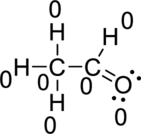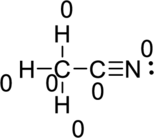
Concept explainers
(a)
Interpretation:
TheLewis structureof Acetaldehyde and a formal charge of each atom have to be written.
Concept Introduction:
A Lewis structure is also known as Lewis dot diagrams or electron dot structures. The bond between atoms and lone pairs of electrons that is present in the molecule. Lewis structure represents each atom and their position in structure using the chemical symbol. Excess electrons forms the lone pair are given by pair of dots, and are located next to the atom.
The formula for the formal charge can be written as
(a)
Explanation of Solution
The correct Lewis structure of the Acetaldehyde can be drawn as,

Draw a chart:
The total number of valence electron is

(b)
Interpretation:
The Lewis structure for
Concept Introduction:
Refer Part (a).
(b)
Explanation of Solution
There are three correct possible Lewis structure for
First structure:

Draw a chart:
The total number of valence electron is

Second structure:

Draw a chart:

Third structure:

Draw a chart:

Therefore, the first of these three structures is the best one because the formal charge on atoms in that structure is lesser value
(c)
Interpretation:
The Lewis structure of
Concept Introduction:
Refer Part (a).
(c)
Explanation of Solution
The correct Lewis structure of the

Draw a chart:
The total number of valence electron is

Hence, the formal charge of the
Want to see more full solutions like this?
Chapter 6 Solutions
OWLV2 FOR MOORE/STANITSKI'S CHEMISTRY:
 ChemistryChemistryISBN:9781305957404Author:Steven S. Zumdahl, Susan A. Zumdahl, Donald J. DeCostePublisher:Cengage Learning
ChemistryChemistryISBN:9781305957404Author:Steven S. Zumdahl, Susan A. Zumdahl, Donald J. DeCostePublisher:Cengage Learning ChemistryChemistryISBN:9781259911156Author:Raymond Chang Dr., Jason Overby ProfessorPublisher:McGraw-Hill Education
ChemistryChemistryISBN:9781259911156Author:Raymond Chang Dr., Jason Overby ProfessorPublisher:McGraw-Hill Education Principles of Instrumental AnalysisChemistryISBN:9781305577213Author:Douglas A. Skoog, F. James Holler, Stanley R. CrouchPublisher:Cengage Learning
Principles of Instrumental AnalysisChemistryISBN:9781305577213Author:Douglas A. Skoog, F. James Holler, Stanley R. CrouchPublisher:Cengage Learning Organic ChemistryChemistryISBN:9780078021558Author:Janice Gorzynski Smith Dr.Publisher:McGraw-Hill Education
Organic ChemistryChemistryISBN:9780078021558Author:Janice Gorzynski Smith Dr.Publisher:McGraw-Hill Education Chemistry: Principles and ReactionsChemistryISBN:9781305079373Author:William L. Masterton, Cecile N. HurleyPublisher:Cengage Learning
Chemistry: Principles and ReactionsChemistryISBN:9781305079373Author:William L. Masterton, Cecile N. HurleyPublisher:Cengage Learning Elementary Principles of Chemical Processes, Bind...ChemistryISBN:9781118431221Author:Richard M. Felder, Ronald W. Rousseau, Lisa G. BullardPublisher:WILEY
Elementary Principles of Chemical Processes, Bind...ChemistryISBN:9781118431221Author:Richard M. Felder, Ronald W. Rousseau, Lisa G. BullardPublisher:WILEY





